Introduction
In India, Wheat (Triticum spp.) is the second most important winter cereal after rice that contributes substantially to the National food security by providing more than 50% of the calories to the people who mainly depend on it.1 Drought adversely affects plant growth and development, seed germination,2, 3, 4 seedling growth,5 enzyme activity,6 DNA, RNA, protein synthesis7 and mitosis.8 Fresh and dry mass production of crop was reduced due to adverse effect of water stress.9 Drought imposes one of the commonest and most significant constraints to agricultural production, seriously affecting crop growth, gene expression, distribution, yield and quality.10-12 Plant may be affected by drought at any time of life, but certain stage such as germination and seedling growth are critical.13 In most of the developing countries, wheat is mainly grown in rainfed lands without supplementary irrigation. About 37% of land area in these countries consists of semiarid environments in which available moisture constitutes a primary constraint to wheat production.14 Indian wheat breeding programme is facing the challenge of stagnating productivity and second generation problems of rice-wheat cropping system, increasing heat in north-eastern plain along with other associated problems, declining profit due to increase in cost of production and fear of epidemic out break due to increased genetic uniformity at the farmers field.15
Seed size is an important parameter, which influences the germination, growth and biomass of the nursery seedlings and that trend leads to the future crop. Sowing of the mixed seed of a species may result in non uniform density of seedlings, which may lead to heterogeneity in the vigour and size of the seedlings.16-18 The seed size often controls the germination and initial seedling growth in many tree species.19 Different size of seeds having different levels of starch and other food storage may be one factor which influences the expression of germination and growth of the plants.20 Germination may be dependent on the ability of seed to utilize reserves more efficiently,21 by mobilization of seed reserves for germination traits.22 Seed grading based upon their size and weight is a common practice to regulate the germination and subsequent seedling growth. Therefore, in the present study, an attempt has been made with the objective to determine the effect of seed size and water stress on seed germination and early seedling growth in three Indian varieties (PBW-154, UP-2338 and UP-2425) of wheat (Triticum aestivum L.).
Materials and Methods
The present study has been carried out in the laboratory of Department of Botany, DSB Campus, Kumaun University, Nainital in the year 2014. The seeds of three locally and extensively used varieties of wheat named PBW-154, UP-2338 and UP-2425 were collected from the G.B. Pant University of Agriculture & Technology, Pantnagar. On the basis of diameter, the seeds were categorized into three size classes viz. small (0.2 – 0.25 cm), medium (0.26 – 0.30 cm) and large size class (0.31 – 0.38 cm).
Water Stress Experiment
Three levels of external water stress (-5, -10 and -15 bars) were produced by mannitol solution, according to the formula given by Helmericls and Pfeifer.23
![]()
Where ΨP = Osmotic potential of mannitol solution (water stress)
In addition, distilled water is used to maintain control. Healthy and uniform seeds of all varieties were surface sterilized and washed with distilled water. The seeds were placed in sterile petri dishes (9 cm diameter) lined with two sterile Whatman No. 1 filter papers in 5 ml of distilled water or the respective mannitol solutions. There were 10 seeds per petri dish and three replicate in each treatment of each size class. Germination test were conducted under condition of 12 h light/dark cycle with 140C minimum and 240C maximum temperature. Number of germinated seeds was recorded daily after sowing of seeds up to 15 days. A seed was considered germinated when visible protrusion of plumule was observed. After 15 days seedlings were harvested. Root and shoot length, fresh and dry weights were recorded for each variety, size class and treatment.
After final count, germination percentage (GP) and germination rate (GR) were calculated by the following formulae.24

Effects of seed size and treatments on seedling growth were analyzed by Fisher’s analysis of variance (ANOVA). Differences between mean values for treatments were tested by Tukey’s LSD test. All statistical analyses were performed using the SPSS 16 package.
Results
Effect on Shoot and Root Length
Among all the three varieties the maximum shoot length (SL) was measured in controlled condition of medium sized seeds of UP-2425 (11.43 cm) and UP-2338 (11.16 cm). In all the varieties, the shoot and root length (RL) gradually decreased towards higher water stress levels so that the maximum SL was recorded in the controlled condition for all varieties along with all size classes (Figure 1). The maximum (7.79 cm) RL was measured in the large seed size class of PBW-154 variety in -5 bar stress level.
Effect on Shoot and Root Dry Weight
Among all the varieties, the large sized seeds of UP-2338 variety had the highest shoot dry weight (SDW = 0.104 g) at controlled condition and the lowest dry weight was recorded for small size class of variety UP-2425 in -15 bar water stress level. Root dry weight (RDW) was highest (0.068 g) for medium size class of UP-2425 variety in controlled condition. Variety PBW-154 had the maximum RDW (0.066 g) in large seed size class at -5 bar water stress level whereas UP-2338 variety had the maximum RDW (0.066 g) in controlled condition (Figure 2).
Effect on Seedling Growth
The maximum effect of water stress was recorded on small seed size class of all the three varieties. The large sized seeds had the highest seedling growth in two varieties PBW-154 (16.3 cm) and UP-2338 (16.6 cm) whereas in variety UP-2425 it was 19.1 cm (Figure 3). The seedling growth gradually decreased towards higher water stress level.
Effect on Germination Rate
The germination rate was maximum (13.08) in large seed size class of variety PBW-154 at -10 bar water stress level. The minimum (2.5) germination rate was obtained in the small sized seeds of variety UP-2425 at -15 bar water stress level (Figure 4).
Effect on Germination Percentage (GP)
The minimum germination percentage (33.3 %) was observed in small seed size class of variety UP-2425 at -15 bar water stress level. The GP for variety PBW-154 ranged from 93.3-100 % and for variety UP-2338 it ranged between 90 and 100 % (Figure 5).
Effects on Initiation and Completion of Germination
The early initiation of germination was recorded in small sized seeds of variety PBW-154 and UP-2338, whereas it was delayed in variety UP-2425. Time taken to initiate and complete the germination processes varied in different seed size classes of all the three wheat varieties. The emergence time was 4-5 days for all three varieties at controlled condition but with an increase in water stress levels there was a regular delay in emergence in variety UP-2425. UP-2338 variety showed better performance in initiation and completion of emergence rather than the rest two varieties.
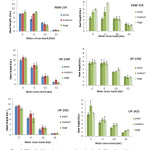 |
Figure 1: Effect of seed size and water stress on shoot and root length of three wheat varieties. |
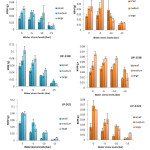 |
Figure 2: Effect of seed size and water stress on shoot dry weight (SDW), root dry weight (RDW) of three wheat varieties. |
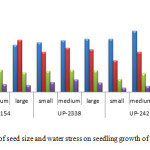 |
Figure 3: The effect of seed size and water stress on seedling growth of three wheat varieties. |
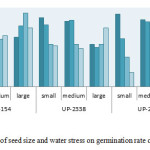 |
Figure 4: The effect of seed size and water stress on germination rate of three wheat varieties. |
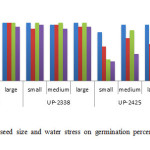 |
Figure 5: The effect of seed size and water stress on germination percentage (%) of three wheat varieties. |
Discussion
Effect of Water Stress
The results of present study indicated that the SL and RL were highly sensitive to the water stress as they showed minimum growth at highest water stress level. Water stress had significantly affected (P< 0.05) to SL, RL, SDW and RDW (Table 1). Water stress has been found to limit growth in several tree seedlings such as Virola surinamensis,25Antidesma cuspidatum, Hopea grithii, Vatica maingayi,26Acacia nilotica, Mundulea,27 and Grevillea robusta.28 In all the seed size classes of all the 3 varieties, maximum length of shoot occurred in controlled conditions.
Under controlled condition PBW-154 and UP-2338 (100%) had the highest and UP-2425 (83.3%) had the lowest germination percent. The 100% germination percentage was recorded in two wheat varieties (PBW-154 and UP-2338) at different water stress levels in different seed size classes, whereas a delay in initiation and completion of seed germination was occurred. Water stress had the highest impact on variety UP-2425 as its germination percent was 33.3% at -15 bar stress level. Hegarty29 indicated that water stress at germination stage can result in delayed and reduced germination or may prevent germination completely.
Table 1: Variance Analysis (ANOVA) for the Traits Investigated for the Three Varieties in Response to Water Stress.
| Mean of Square | |||||
| Parameters |
Df |
SL |
RL |
SDW |
RDW |
| Variety |
2 |
27.72ns |
11.63ns |
0.003* |
0.002ns |
| Size |
2 |
12.81ns |
24.35* |
0.005* |
0.008* |
| Treatment |
3 |
1338.3* |
263.7* |
0.016* |
0.007* |
Df, SL, RL, SDW, RDW, ns and * respectively, are Degree of freedom, shoot length, root length, shoot dry weight, root dry weight, not significant and significant at 0.05 level of probability
Effect of Seed Size
ANOVA showed that the effect of seed size was significant on RL, SDW and RDW whereas on the SL it was insignificant (Table 1). The germination rate was maximum (12.25 and 12.87) for small seed size class of varieties PBW-154 and UP-2338, respectively whereas it was maximum (13.08) in large seed size class of variety UP-2425. Large sized seeds recorded highest seed germination (91.9%) followed by medium (89.7%) and small (82.8%) sized seeds. Higher and quicker germination in large sized seeds may be due to the presence of higher amount of carbohydrates and other nutrients than in medium and small sized seeds. Seedling height, root and shoot length and dry weights were also higher for large seeds than those of medium and small seeds (Table 2). Gunaga et al.,30 also reported that large seeds germinate quicker and would take lesser duration when compared to that of smaller ones. The highest effect of seed size was observed in GP of variety UP-2425 as it was highly sensitive to water stress. The germination rate of small sized seeds was highest among other seed sizes, probably because of less need for water absorption compared to large seed size. Large seeds need more water absorption than small seeds and because of this, it takes more time to germinate and finally resulted in decline in germination rate.31 The SDW and RDW were least in small seed size class among all the varieties. Ghorbani et al.,32 reported that seed size had significant effect on seedling dry weight. Also they observed that small seed size produced higher germination rate as compared to large seed size which was in agreement with our results. Effect of seed size (less than 1.95, 1.95-2.35 and more than 2.35 mm) on germination characteristics of six oat (Avena sativa L.) cultivars under water stress condition showed that germination was increased with increasing seed size.33
Table 2: Means (± SE) Comparison of effects of Variety, Seed Size and Water Stress on Various Growth Parameters of Wheat.
| Traits | |||||
| SL (cm) RL (cm) SDW (g) RDW (g) GP (%) | |||||
| Variety | |||||
| PBW-154 | 4.75±0.99 | 3.96±0.93 | 0.03±0.004 | 0.03±0.004 | 98.06±0.64 |
| UP-2338 | 5.89±0.96 | 4.25±0.46 | 0.05±0.008 | 0.04±0.004 | 96.39±1.7 |
| UP-2425 | 5.25±0.99 | 3.55±0.98 | 0.03±0.008 | 0.03±0.006 | 70.04±6.2 |
| Size (cm) | |||||
| Small | 4.86±0.55 | 3.41±0.44 | 0.03±0.007 | 0.02±0.009 | 82.8±7.2 |
| Medium | 5.80±0.96 | 4.08±0.56 | 0.04±0.007 | 0.04±0.004 | 89.7±4.4 |
| Large | 5.23±0.96 | 4.26±0.56 | 0.05±0.008 | 0.04±0.006 | 91.9±9.2 |
| Treatment (bar) | |||||
| 0 | 9.84±0.40 | 5.70±0.34 | 0.06±0.007 | 0.05±0.005 | 96.7±1.8 |
| -5 | 7.29±0.34 | 5.03±0.45 | 0.05±0.005 | 0.04±0.004 | 89.8±5.4 |
| -10 | 3.04±0.17 | 3.2±0.18 | 0.03±0.004 | 0.03±0.004 | 89.1±6.8 |
| -15 | 0.76±0.15 | 1.72±0.13 | 0.009±0.001 | 0.01±0.009 | 81.1±7.9 |
SL, RL, SDW, RDW and GP respectively, are shoot length in centimeter, root length in centimeter, shoot dry weight in gram, root dry weight in gram and germination percentage
Towards higher water stress levels all the growth parameters decreased significantly as indicated by best performance at controlled condition. On the basis of overall performance it can be suggested that PBW-154 (98.06%) variety had best germination characteristics and was less affected by water stress during establishment.
References
- Singh, S. S. Wheat production in India and future prospects. 8th international wheat conference. St. Petersburg, Russia, (2010).
- Dash, M. and Panda, S. K. Salt stress induced changes in growth and enzyme activities in germinating Phaseolus muingo seeds. Biol. Plantarum. 44: 587-589 (2001).
CrossRef - Almaghrabi, O. A. Impact of drought stress on germination and seedling growth parameters of some wheat cultivars. Life Sci. J. 9: 590-598 (2012).
- Vibhuti, Shahi, C. Bargali, K. and Bargali, S. S. Seed germination and seedling growth parameters of rice (Oryza sativa L.) varieties as affected by salt and water stress. Indian J Agr. Sci. 85:102-108 (2014).
- Ashraf, M. Y. Sarwar, G. Ashraf, M. Afaf, R. and Sattar, A. Salinity induced changes in 4-amylase activity during germination and early cotton seedling growth. Biol. Plantarum. 45: 589-591 (2002).
CrossRef - Seckin, B. Sekmen, A. H. and Turkan, I. An enhancing effect of exogenous mannitol on the antioxidant enzyme activities in radicles of wheat under salt stress. J. Plant Growth Regul. 28: 12-20 (2009).
CrossRef - Anuradha, S. and Rao, S. S. R. Effect of brassinosteroids on salinity stress induced inhibition of seed germination and seedling growth of rice (Oryza sativa L.). J. Plant Growth Regul. 33: 151-153 (2001).
CrossRef - Tabur, S. and Demir, K. Role of some growth regulators on cytogenetic activity of barley under salt stress. Plant Growth Regul. 60: 99-104 (2010).
CrossRef - Farooq, M. Wahid, A. Kobayashi, N. Fujita, D. and Basra, S. M. A. Plant drought stress: effects, mechanisms and management. Agron. Sustain. Dev. 29: 185-212 (2009).
CrossRef - Yang, X. Q. Zhang, S. Q. Liang, Z. S. and Shan, Y. Effects of water stress on chlorophyll fluorescence parameters of different drought resistance waiter wheat cultivars seedlings. Acta Bot. Boreal. Occident. Sin. 24: 812-816 (2004).
- Shi, G. Y. Liao, W. X. Qin, L. F. and Lu, L. L. PEG simulated water stress effects on physiological and biochemistry indexes of germination of Toona sinensis seeds. J. Forest. Sci. Technol. 4: 142-145 (2009).
- Shi, Z. Shi, S. Q. Xiao, W. F. and Qi, L. W. Influence of dehydration on characteristics of chlorophyll fluorescence of detached leaves in Haloxylon ammodendron and Populus euphratica. Forest Res. 21: 566-570 (2008).
- Pessarakli, M. Handbook of plant and crop stress. 2nd Ed., New York: Marcel Dekker Inc. 247-259 (1999).
CrossRef - Abdul, Q. Razzaq, A. Muhammad, A. and Matthew, A. Water stress causes differential effects on germination indices, total soluble sugar and proline content in wheat (Triticum aestivum L.) genotypes. Afr. J. Biotech. 10: 14038-14045 (2001).
CrossRef - Yadav, R. Singh, S. S. Jain, N. Singh, G. P. and Prabhu, K.V. Wheat Production in India: Technologies to Face Future Challenges. J. Agr. Sci. 2: 164-173 (2010).
- Bargali, S. S. Singh, S. P. and Pandya, K. S. Effects of Acacia nilotica on gram crop in a traditional agroforestry system of Chhattisgarh plains. Int. J. Ecol. Environ. Sci. 30: 363-368 (2004).
- Bargali, S. S. Bargali, K. Singh, L. Ghosh, L. and Lakhera, M. L. Acacia nilotica based traditional agroforestry system: effect on paddy crop and management. Curr. Sci. 96: 581-587 (2009).
- Mishra, A. Swamy, S. L. Bargali, S. S. and Singh, A. K. Tree growth, biomass and productivity of wheat under five promising clones of Populus deltoids. Int. J. Ecol. Environ. Sci. 36: 167-174 (2010).
- Murali, K. S. Patterns of seed size, germination and seed viability of tropical tree species in Southern India. Biotropica. 29: 271- 279 (1997).
CrossRef - Wood, D. W. Longden, P. C. and Scott, R. K. Seed size variation, its extent, source and significance in field crops. Seed Sci. Technol. 2: 337-352 (1977).
- Rao, D. G. and Sinha, S. K. Efficiency of mobilization of seed reserves in sorghum hybrids and their parents as influenced by temperature regimes. Seed Res. 2: 97-100 (1993).
- Penning de Vries, F. W. T. Witlage, J. M. and Kremer, D. Rate of respiration and increase in structural dry matter in young wheat, rye grass and maize plants in relation to temperature, to water stress and to their sugar content. Ann. Bot. 44: 595-609 (1979).
CrossRef - Helmericles, R. H. and Pfeifer, R. P. Differential varietal responses of winter wheat germination and early growth to controlled limited moisture conditions. Agron J. 46: 560-562 (1954).
CrossRef - Raun, S. Xue, Q. and Thlkowska, K. Effect of seed priming on germination and health of rice (Oryza sativa L) seeds. Seed Sci.Technol. 30: 451-458 (2002).
- Fisher, B. L. Howe, H. F. and Wright, S. J. Survival and growth of Virola surinamensis yearlings, water augmentation in gap and understory. Oecologia. 86: 292-297 (1991).
CrossRef - Burslem, D. F. R. P. Grubb, P. J. and Turner, I. M. Responses to simulated drought and elevated nutrient supply among shade-tolerant tree seedlings of lowland tropical forest in Singapore. Biotropica. 28: 636-648 (1996).
CrossRef - Wilson, T. B. and Witkowski, E. T. F. Water requirements for germination and early seedling establishment in four African savanna woody species. J. Arid. Environ. 38: 541-550 (1998).
CrossRef - Nautiyal, S. Negi, D. S. Pal, M. and Chaukiyal, S. P. Plant responses to water stress and antitranspirants: changes in growth and dry matter production of Grevillea robusta A. Cunn. Indian For. 122: 43-50 (1996).
- Hegarty, T. W. Seed activation and seed germination under moisture stress. New Phytol. 78:349-359 (1977).
CrossRef - Gunaga, R. P. Hareesh, T. S. and Vasudeva, R. Effect of fruit size on early seedling vigour and Biomass in White Dammer (Vateria indica): a vulnerable and economically important tree species of the Western Ghats. J. NTFPs. 14: 197-200 (2007).
- Sadeghi, H. Khazaei, F. Sheidaei, S. and Yari, L. Effect of seed size on seed germination behavior of safflower (Carthamus tinctorius L.). ARPN J. Agr. Biol. Sci. 6: 5-8 (2011).
- Ghorbani, M. H. Soltani, A. Amiri, S. The effect of salinity and seed size on response of wheat germination and seedling growth. J. Agric. Sci. Natur. Resour. 14: (2008).
- Willenborg, C. J. Wildeman, J. C. Miller, A. K. Rossnaged, B. G. and Shirtliffe, S. J. Oat germination characteristics differ among genotypes, seed sizes and osmotic potentials. Crop Sci. 45: 2023-2029 (2005).
CrossRef
